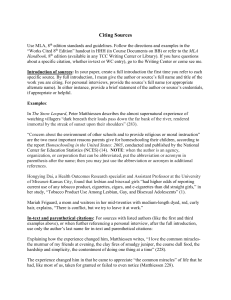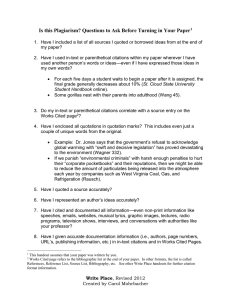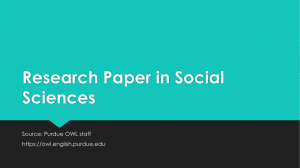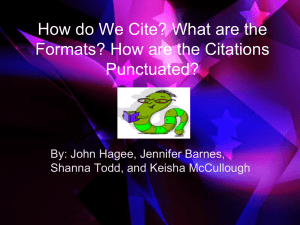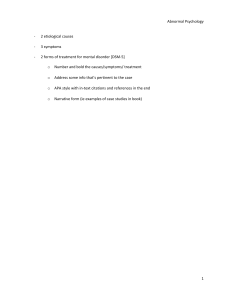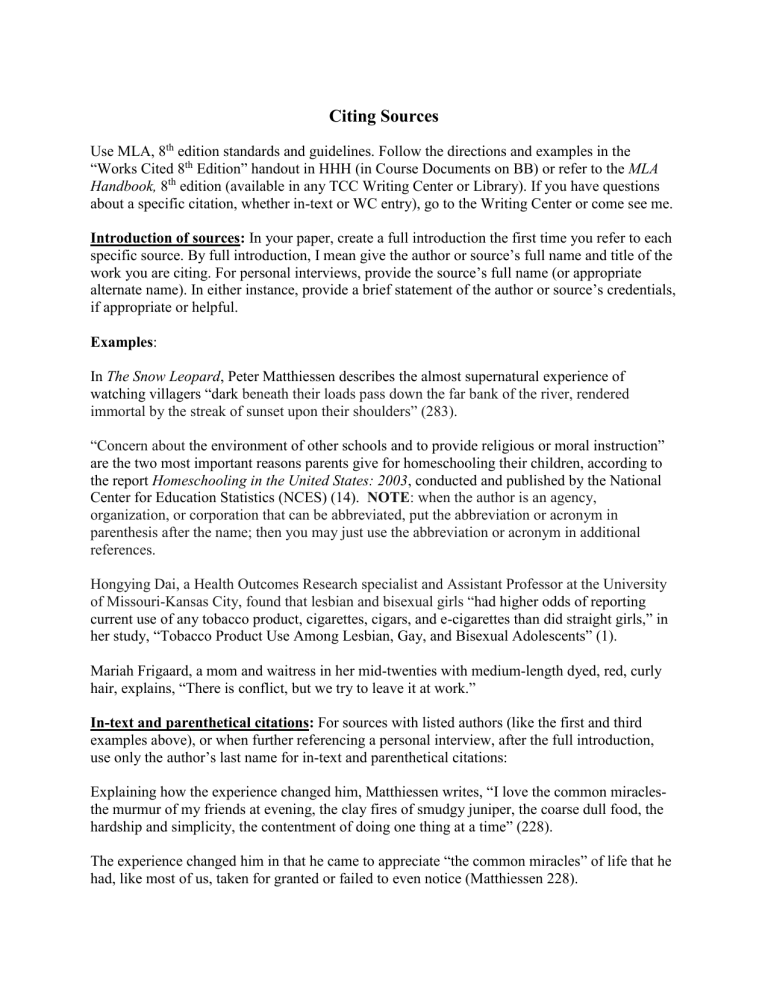
Citing Sources Use MLA, 8th edition standards and guidelines. Follow the directions and examples in the “Works Cited 8th Edition” handout in HHH (in Course Documents on BB) or refer to the MLA Handbook, 8th edition (available in any TCC Writing Center or Library). If you have questions about a specific citation, whether in-text or WC entry), go to the Writing Center or come see me. Introduction of sources: In your paper, create a full introduction the first time you refer to each specific source. By full introduction, I mean give the author or source’s full name and title of the work you are citing. For personal interviews, provide the source’s full name (or appropriate alternate name). In either instance, provide a brief statement of the author or source’s credentials, if appropriate or helpful. Examples: In The Snow Leopard, Peter Matthiessen describes the almost supernatural experience of watching villagers “dark beneath their loads pass down the far bank of the river, rendered immortal by the streak of sunset upon their shoulders” (283). “Concern about the environment of other schools and to provide religious or moral instruction” are the two most important reasons parents give for homeschooling their children, according to the report Homeschooling in the United States: 2003, conducted and published by the National Center for Education Statistics (NCES) (14). NOTE: when the author is an agency, organization, or corporation that can be abbreviated, put the abbreviation or acronym in parenthesis after the name; then you may just use the abbreviation or acronym in additional references. Hongying Dai, a Health Outcomes Research specialist and Assistant Professor at the University of Missouri-Kansas City, found that lesbian and bisexual girls “had higher odds of reporting current use of any tobacco product, cigarettes, cigars, and e-cigarettes than did straight girls,” in her study, “Tobacco Product Use Among Lesbian, Gay, and Bisexual Adolescents” (1). Mariah Frigaard, a mom and waitress in her mid-twenties with medium-length dyed, red, curly hair, explains, “There is conflict, but we try to leave it at work.” In-text and parenthetical citations: For sources with listed authors (like the first and third examples above), or when further referencing a personal interview, after the full introduction, use only the author’s last name for in-text and parenthetical citations: Explaining how the experience changed him, Matthiessen writes, “I love the common miraclesthe murmur of my friends at evening, the clay fires of smudgy juniper, the coarse dull food, the hardship and simplicity, the contentment of doing one thing at a time” (228). The experience changed him in that he came to appreciate “the common miracles” of life that he had, like most of us, taken for granted or failed to even notice (Matthiessen 228). Dai continues, “In contrast, sexual minority boys were far more similar in smoking behaviors compared with straight boys” (6). However, she found little differences between the “smoking behaviors” of “sexual minority” and “straight” boys (Dai 6). Frigaard proudly describes the café’s commitment to the community as she shows me trophies and pictures from several of the local high school’s sports teams that are displayed prominently near the entry. (NOTE: if you interview multiple sources with the same last name, you may – for this assignment only – reference each by first name only after the formal introduction.) For sources with a corporate, organization, or government author, like the National Center for Education Statistics example above, use the abbreviated name or acronym in subsequent references: The homeschooling study also cites the third most common reason for homeschooling as “dissatisfaction with the academic instruction available at other schools” (NCES 15). For sources with no listed author, use the title (shortened or full) for in-text or parenthetical citations: As the article “Decade of the Spy” reveals, international espionage was as prevalent as ever in the 1990s (26). International espionage was as prevalent as ever in the 1990s (“Decade” 26). Works Cited Entries The information in parenthesis is simply there to offer explanations about the entry. DO NOT include parenthesis or notes in your WC entries. “Advanced Social Curve Design.” YouTube, 1 July 2015, youtube.com/watch?v=ggDB6eSyQf8. Accessed 20 April 2017. (YouTube video) Cole, Helena, and Mark D. Griffiths. "Social Interactions in Massively Multiplayer Online RolePlaying Gamers." Cyberpsychology & Behavior, vol. 10, no. 4, Aug. 2007, pp. 575-583. EBSCOhost, ocw.metu.edu.tr/file.php/85/ceit706/week6/Cole%26Griffiths. PDF. Accessed 19 Apr. 2017. (PDF article in a journal accessed through an online database – note that both the journal and database titles are italicized) Dragons. “The Syndicate Celebrated its 15th Anniversary in Feb 2011.” The Syndicate, 5 May 2011, llts.org/Articles/Articles/108_15th_anniv_sotw.php. Accessed 15 Apr. 2017. (A blog post from a website; notice the author uses a pseudonym, in this case a player name) Nielsen, Rachel. "Technology (A Special Report); their Own World: Online Role-Playing Games Offer Players Interaction in a Fantasy World; Who are these People, Anyway?" Wall Street Journal, Eastern ed. 26 Apr. 2004, ProQuest, libraryproxy.tulsacc.edu:2135/wallstreetjournal/docview/398866361/abstract/2C442E284 B2B4FB7PQ/1?accountid=58. Accessed 20 Apr. 2017. (An article in a journal in an online database) The Village. Dir. M. Night Shyamalan. Perf. Joaquin Phoenix, Adrien Brody, Bryce Dallas Howard, and William Hurt. DVD. Buena Vista, 2005. (DVD) Citing Multiple Works by the Same Author There are times you will need to cite more than one work by the same author, as may be necessary when citing stories from Brkic’s book, Stillness and Other Stories. Example in-text citations for multiple works by one author: Parenthetical citations should include the author’s last name, the first major word of the story’s title in quotation marks, and the page number(s) in which the quoted material appears. The only punctuation inside the parenthesis is a comma after the author’s last name. See examples below: N. initially finds comfort in anonymity, his own and the blocks of identical buildings that depersonalize the city, yet becomes increasingly disturbed by feelings of “uneasy recognition” (Brkic, “Angled” 71), stirring up memories that make N. face the humanity he is trying to deny. Similarly, Antonio first likes being indistinguishable from the other soldiers, but changes his mind once the “implications of anonymity [sink] in” (Brkic, “Where” 61). The parenthetical citations Example WC page entry for multiple works by the same author (in an anthology): Brkic, Courtney Angela. “The Angled City.” Stillness and Other Stories. New York, Picador, 2003, pp. 70-81. ---. “Where None is the Number.” Stillness and Other Stories. New York, Picador, 2003, pp. 6075. Personal Interviews: The entries for person interviews are very simple to create; just use the following format, but do not include the information in parenthesis: Frigaard, Mariah. Personal Interview. 21 Feb. 2015. (Source provides full name) F., Mariah. Personal Interview. 21 Feb. 2015. (Source prefers to provide only the last initial) Mariah. Personal Interview. 21 Feb. 2015. (Source prefers first name only or uses a pseudonym) Clownprince158. Personal Interview. 18 Apr. 2017. (Source prefers online username) This is not a complete list of all the different types of commonly used sources for academic work. For additional assistance, refer to the MLA handouts (in HHH on Bb) or go to the Writing Center for help with creating correctly formatted WC entries.
